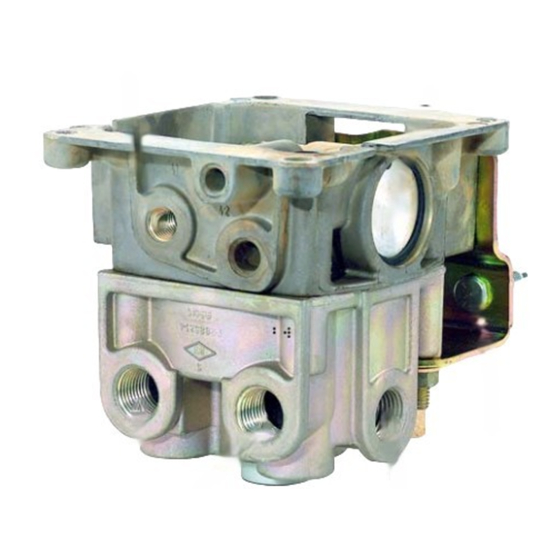BENDIX AR-1 ANTILOCK RELAY VALVE Handbuch - Seite 7
Blättern Sie online oder laden Sie pdf Handbuch für Kontrolleinheit BENDIX AR-1 ANTILOCK RELAY VALVE herunter. BENDIX AR-1 ANTILOCK RELAY VALVE 8 Seiten. Antilock relay valve

DISASSEMBLY
GENERAL
The following disassembly and assembly procedure is
presented for reference purposes only and presupposes
that the appropriate maintenance kit is on hand at the time
of disassembly. The instructions provided with the
maintenance kit should always be used in lieu of those
presented here. Refer to figure 6 throughout the disassembly
and assembly procedure.
™
CAUTION: The AR-1
valve may be lightly clamped in a
bench vise during disassembly, however, over clamping will
cause damage to the valve and result in leakage and/or
malfunction. If a vise is to be used, position the valve so
that the jaws bear on the supply ports on opposing sides of
the valve's body.
1. Remove all air fittings and plugs from the valve.
2. Mark the relationship of the antilock electronic controller
and valve cover to the body (5). Note the position of the
mounting bracket and mark the relationship of the bracket
to the valve body, cover, and antilock controller. Remove
and retain the four cap screws and lock washers (1) that
secure the controller to the cover (15), then carefully
remove the electronic controller without damaging its
gasket (2).
3. While holding the exhaust cover (4), remove and discard
the retaining ring (3) that secures it to the body (5).
4. Remove and discard the exhaust cover (4) along with
both o-rings (6 & 7).
5. Remove and discard the valve spring (8), valve retainer
(9), and the valve assembly (10) from the body (5).
6. Remove and retain the two cap screws (11) and lock
washers (12) that secure the cover (15) to the body (5).
Remove and retain the two bolts (13), lock washers (12),
and nuts (14) that secure the cover (15) and mounting
bracket to the valve body (5).
7. Separate the cover (15) and mounting bracket from the
body (5), then remove and discard the sealing ring (16).
Remove and retain the two cap screws and lockwashers
(26) that secure the bracket to the cover (15).
8. Remove and retain the relay piston (17) and relay piston
spring (19) from the body (5). NOTE: The relay piston
spring, item 19 is not used in all valves.
9. Remove and discard the o-ring (18) from the relay piston
(17).
10. Remove and retain the service port cap nut (20) from the
cover (15), then separate and discard the cap nut o-ring
(21) from the cap nut.
11. Remove and discard the quick exhaust diaphragm (22)
from the cover (15).
12. Remove the quick exhaust diaphragm retaining screw
(23), the diaphragm washer (24) and the diaphragm (25)
from the cover (15).
CLEANING & INSPECTION
1. Using mineral spirits or an equivalent solvent, clean and
thoroughly dry all metal parts.
2. Inspect the interior and exterior of all metal parts that
will be reused for severe corrosion, pitting and cracks.
Superficial corrosion and/or pitting on the exterior
portion of the body (5) and cover (15) is acceptable.
Replace the entire valve if the interior of the body or cover
exhibit signs of corrosion or pitting.
3. Inspect the bores of both the body (5) and cover (15) for
deep scuffing or gouges. Replace the entire valve if
either are found.
4. Make certain all air channels and exhaust passages in
the valve cover (15) are clear and free of obstruction.
5. Inspect the pipe threads in the body (5). Make certain
they are clean and free of thread sealant.
6. Wash all non-metallic components in a soap and water
solution making certain to rinse and dry thoroughly.
Inspect each non-metallic component for cracks, wear
or distortion. Replace the entire valve if these conditions
are found.
7. If the valve was equipped with a relay piston spring (19),
inspect it for signs of corrosion, pitting and cracks.
Replace as necessary.
8. Inspect all air line fittings for corrosion and replace as
necessary. Make certain to remove all old thread sealant
before reuse.
ASSEMBLY
1. Prior to assembly, lubricate all o-rings, seals, and pistons,
as well as body bores, using the lubricant provided with
the Bendix maintenance kit.
2. Install the valve retainer (9) on the inlet and exhaust valve
(10) so that the flange of the retainer (9) surrounds the
rubber portion of the valve. Install the inlet and exhaust
valve in the body (5).
3. Install the inlet and exhaust valve return spring (8) in the
body (5).
4. Install the large and small diameter o-rings (7 & 6) in the
exhaust cover (4), then install the exhaust cover in the
body (5) taking care not to damage the o-rings. Hold the
exhaust cover in place.
5. While depressing the exhaust cover (4), install the
retaining ring (3) in the body (5). Make certain the retainer
(3) is fully seated in its groove in the body.
™
6. If the AR-1
valve was equipped with a relay piston return
spring (19), install the spring in the body, large diameter
first.
7
